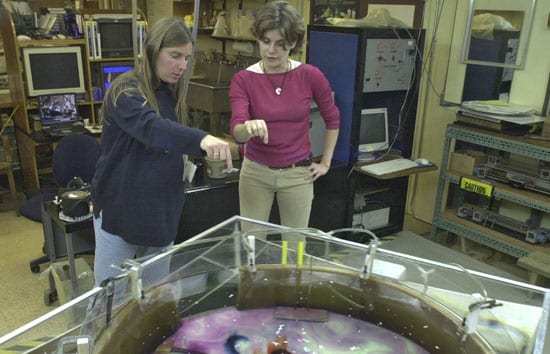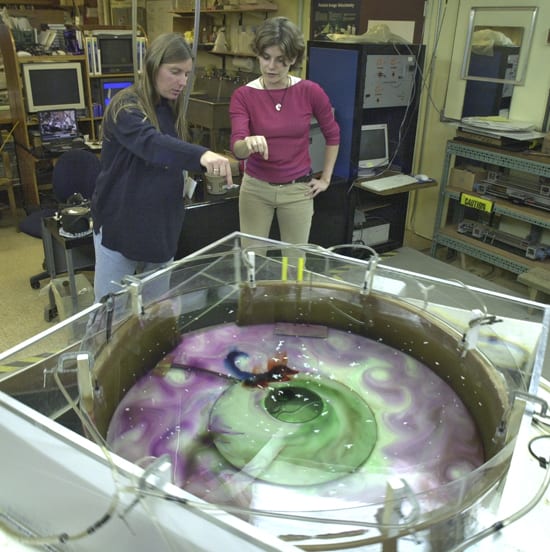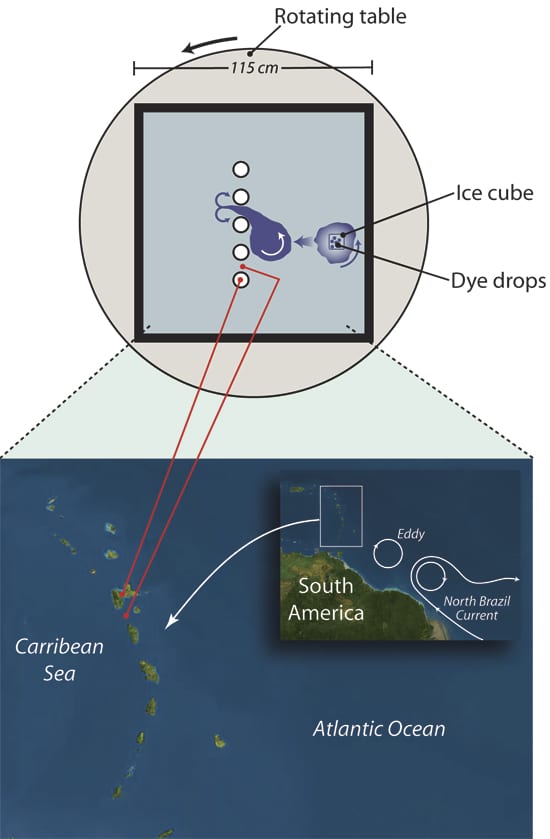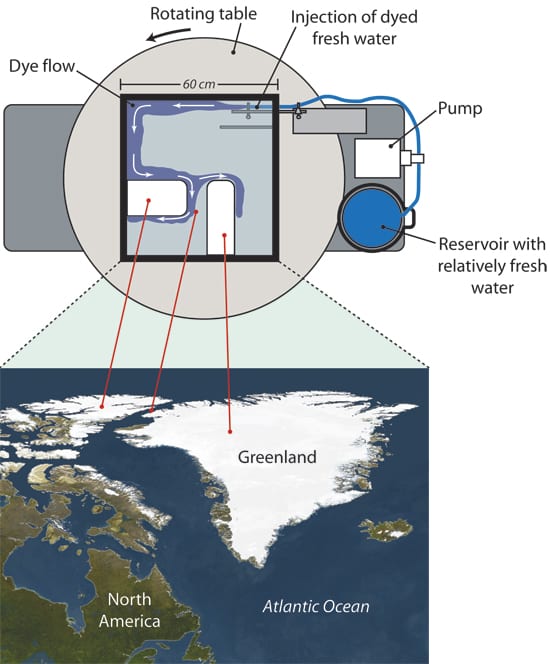
The Ocean—Captured in a Box
An "experimentalist" encapsulates ocean fluid dynamics in the lab
Claudia Cenedese prides herself on thinking inside the box. Her boxes are made of Plexiglass, and they contain the oceans—but on a miniature scale.
Most oceanographers make tiny observations in a vast ocean to piece together the big picture of how it moves and works. Theoreticians start with the big picture, weaving the laws of physics into equations that can never contain all the intricacies of the real ocean. Somewhere in between is Cenedese, a physical oceanographer at Woods Hole Oceanographic Institution, who describes herself as an experimentalist.
In the WHOI Geophysics Fluid Dynamics (GFD) Laboratory, she telescopes real-ocean scenarios into her boxes. The same basic laws that govern fluid dynamics in the boxes also apply in the real ocean, and Cenedese’s experiments reveal on a small scale what would be impossible to see and encompass at sea.
Her oceans-in-a-box are not bathtubs filled with stagnant, homogenous water. Like the ocean, they contain distinct masses of water with different salinities and densities, which tend to remain separate but flow in interweaving patterns. The box sits on a spinning table that mimics Earth’s rotation, simulating the Coriolis effect on the ocean.
The different water masses are color-coded with food dye to observe more easily how they move and mix. An overhanging camera rotates in synchrony with the table, providing a detailed visual record of the waters’ colorful, swirling motions.
“It’s not the real ocean, but it’s a real fluid; it’s not on paper,” said Cenedese’s colleague Karl Helfrich, who is also an oceanographic “experimentalist” at WHOI. “And, it’s hard to do a controlled experiment out there in the real ocean.”
Controlling the variables
In her miniature oceans, Cenedese can manipulate the variables. She can change water densities, for example, or add plastic islands, continents, or underwater mountains, then shift their geometry.
“Claudia comes up with an idea, and we carry it out,” said Ken Bradley, a research associate in the GFD Lab. “She says, ‘Make me a seamount,’ and I say, ‘Aaaal-right. We can do that.’ It’s all one-of-a-kind. I try to use stuff that is readily available and that doesn’t cost a lot of money.”
In one experiment, Cenedese and Rachel Bueno de Mesquita, a visiting undergraduate from the University of Rome, inserted a 12-centimeter-high plastic mound in the center of their box to investigate how water flows around a seamount sticking 1,000 meters (.62 miles) up from the seafloor. It did not flow randomly, but organized itself into a large eddy, a self-contained spinning parcel of water, that whirled around the base of the seamount.
Next, the scientists tested what would happen if the seamount’s topography were smooth as a desert, or bumpy like the Alps. They repeated the experiments, covering the plastic seamount with chicken wire, plastic grass, sand paper, and insulating foam—each with a texture that produced a quantifiable drag. The rougher the “topography,” the slower the eddy rotated.
In the same way that scientists use wind tunnels to examine aerodynamics, “there is long tradition of studying fluid mechanics in the lab,” Helfrich said. “Sometimes we have a general idea about a phenomenon or process—like the formation of eddies spinning off a current as it goes around a corner of land, for example—but we really want to explore the intimate physics of it: Does it always happen? Under what conditions?”
Canada and Greenland in plastic
In another of her experiments, Cenedese recreated a similar scenario: Into a box, she inserted a block of plastic representing Canada. To the right, another smaller block stood in for Greenland. In between, was a channel, simulating one of the channels in the Canadian archipelago leading to Baffin Bay on the west side of Greenland.
Cenedese injected a stream of relatively fresh water into the box, representing the less salty Pacific Ocean water that flows through the Bering Strait into the Arctic Ocean. As the box (and the Earth) rotates, the fresh water forms a current that hugs the coastline. The question is: How much will be diverted through the channel (and down the west coast of “Greenland”) and how much will continue around the “Greenland” plastic island, through what in the real world would be the Fram Strait, and into the North Atlantic?
The question isn’t entirely academic because in the real world, fresh water flowing out of the Arctic and into the Atlantic can alter ocean circulation and cause climate changes, and melting Arctic sea ice and glaciers could produce more fresh water. Getting the fluid dynamics right offers more reliable predictions of future climate change.
“The theory has all the variables and factors, but in the lab, you can vary the width or depth of the channel, or the depth of the current, or the geometry or ‘smoothness’ of the ‘coastline,’ and test which variables are most critical,” Cenedese said.
Fast eddies
“Numerical models are getting pretty good, but they are still filled with approximations,” Helfrich said. “Laboratory experiments can identify where the theory fails and spur development of more refined and accurate theories.”
Other times, Cenedese said, the experiments turn up things that are completely unexpected and never seen before. “Then I go down the hall to (WHOI physical oceanographer) Dave Fratantoni, who conducts experiments at sea, and say, ‘Have you ever observed something like this?’ And then they can go out and try to observe it in the real ocean.”
Collaborations among theoreticians, observationalists, and experimentalists go in all directions.
“That’s why it’s great to work here at WHOI,” she said. “Colleagues often come into the lab just to visualize large-scale processes, to gain insights into what they observe in the ocean. And I value the ideas for experiments that I get from colleagues.”
For example: Using floats to track the North Brazilian Current off South America’s northeast coast, Fratantoni and WHOI oceanographer Phil Richardson observed great eddies spinning off and heading north toward the Lesser Antilles islands. When they hit the islands, do they break up like bubbles into smaller eddies on the other sides of the islands? How much warm North Brazilian Current waters actually makes it through the island barriers into the Caribbean Sea?
Using plastic islands to represent Barbados, St. Vincent, and Grenada, Cenedese replicated the scenario in a box.
“Claudia has a great eye for choosing problems and going after them in the lab,” Helfrich said.
Claudia Cenedese’s research has been funded by the National Science Foundation. She is a Coastal Ocean Institute fellow at WHOI.
Slideshow

Slideshow
 WHOI physical oceanographer Claudia Cenedese (left) and Rachel Bueno de Mesquita, a visiting researcher from the University of Rome, developed this laboratory experiment on a rotating table in the WHOI Geophysics Fluid Dynamics Laboratory to study fluid flow and eddies around seamounts. (Photo by Tom Kleindinst, Woods Hole Oceanographic Institution)
WHOI physical oceanographer Claudia Cenedese (left) and Rachel Bueno de Mesquita, a visiting researcher from the University of Rome, developed this laboratory experiment on a rotating table in the WHOI Geophysics Fluid Dynamics Laboratory to study fluid flow and eddies around seamounts. (Photo by Tom Kleindinst, Woods Hole Oceanographic Institution)- This laboratory experiment simulates North Brazil Current Rings interacting with the Caribbean island chain. In the ocean, these eddies pinch off the North Brazilian Current and travel northwestward before hitting the Caribbean islands. In the laboratory, cold water from the melting ice cube sinks, creating swirling "eddies"?a technique devised by WHOI oceanographic experimentalist, Jack Whitehead. Dye drops on the ice cube make the eddies easier to observe. (Illustration by Jack Cook,Woods Hole Oceanographic Institution)
- In a laboratory experiment, WHOI physical oceanographer Claudia Cenedese simulates some fluid dynamics that occur in the Arctic Ocean. The "box" rotates as the Earth does, and relatively fresh water forms a coastal current that hugs?and flows between?plastic "coastlines" representing Canada and Greenland. The dye lets scientists visualize and photograph the fluid behavior. (Illustration by Jack Cook, Woods Hole Oceanographic Institution)


